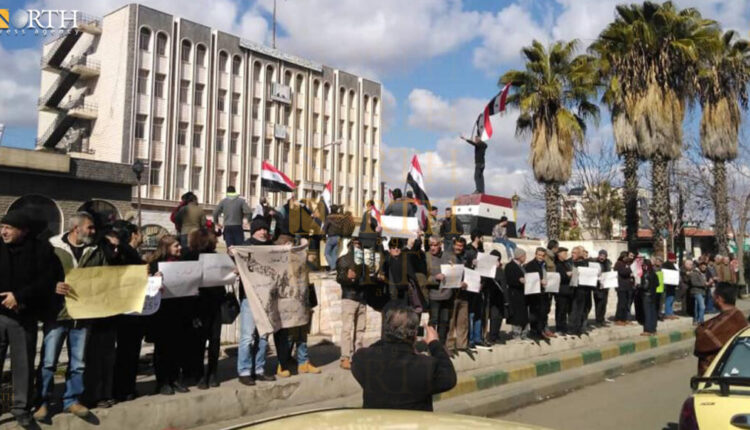
SUWAYDA, Syria (North Press) – Protesters gathered at Karama Square, calling for political and economic change. On the opposite side of the square, a march of government supporters and members of the Baath Party staged a counter-demonstration.
This has been a familiar scene in Suwayda in past weeks. After a decade of war and popular mobilization, Syrian authorities and supporters of the Baath Party are still facing dissent in the same old way. That is to say, by attempting to suppress.
Political activist Muhannad Shihab al-Din believes that the pro-government protests are staged for the media’s sake.
Shihab al-Din stresses that the regime managed to mobilize only dozens of participants for the pro-regime rallies, which “indicates the deep-seated moral corruption of all those who chanted fake patriotic slogans all these years.”
Only the employees who are awaiting their retirement and pension, or those who benefit from the widespread corruption in the governmental institutions participate in pro-government rallies, Shihab al-Din noted.
The political activist calls those who chanted for the government in the face of the anti-government demonstrators “social outcasts”.
Class Struggle
Maxim Murshid, a spokesman for the Syrian Communist Party, believes that the concept of revolutions must include class struggle, “as the conflict between a poor popular class against a dominant ruling class was the main reason for the Syrian revolution”.
Murshid told North Press that the Syrian government used many ideological and political tools to tighten the screw on the country, as the Baath Party was and still is the political instrument it mostly depends on.
After a month of protests in the Suwayda Governorate, which began in early December 2022, the government started mobilizing its supporters and deploying security forces whenever there is a protest.
Murshid believes that the purpose behind the pro-regime rallies parallel to anti-government protests is to increase the possibility of violent confrontations between the two parties.
The aim of such confrontations is to reduce the spread of protests, especially after the number of participants have steadily risen.
Who are the protestors
Most of the participants in the pro-government rallies, which take place in tandem with public protests, were members of the Baath Party.
Murshid describes those who participated as “intellectually incompetent and lacking in awareness” and indicates that they only participate to stay in their current positions.
The high-ranking officials in the Baath Party, who hold power and benefit from social and financial privileges, are behind those who took to streets, Murshid adds.
Baathist allegations
The pro-government rallies included slogans glorifying the Syrian president, Bashar al-Assad, and chants calling for the lifting of US Caesar Act sanctions. The goal is to silence those who protest against the deteriorating economic conditions in the country, by assigning foreign actors the responsibility for the current situation, Murshid says.
Murshid believes that these sanctions “gave the regime and those close to it the opportunity to monopolize imports and exports […] Thus, it was able to easily circumvent the sanctions.”
Murshid wonders, “Why these sanctions only affect the [Syrian] people while those close to the al-Assad regime have piled fortunes, opened fancy restaurants and bought the latest cars?”
Murshid believes that the only way out now is “a fundamental change, which would take place by raising the masses’ awareness of social class, an awareness through which they can change the material reality of society.”
He stresses that the idea of street protests is “advanced” but requires “building a revolutionary political organization capable of being part of any upcoming revolutionary movement.”
